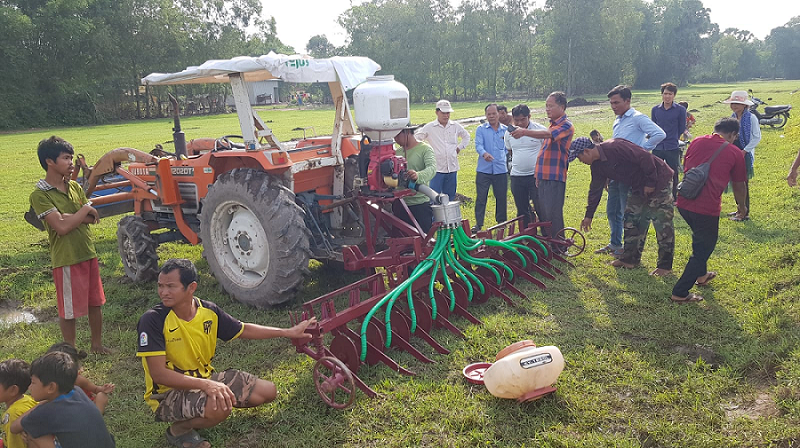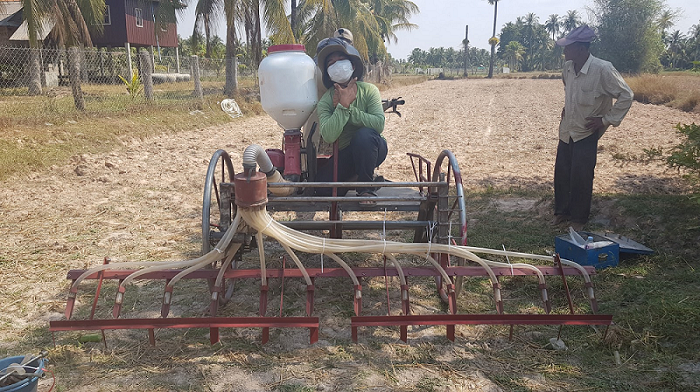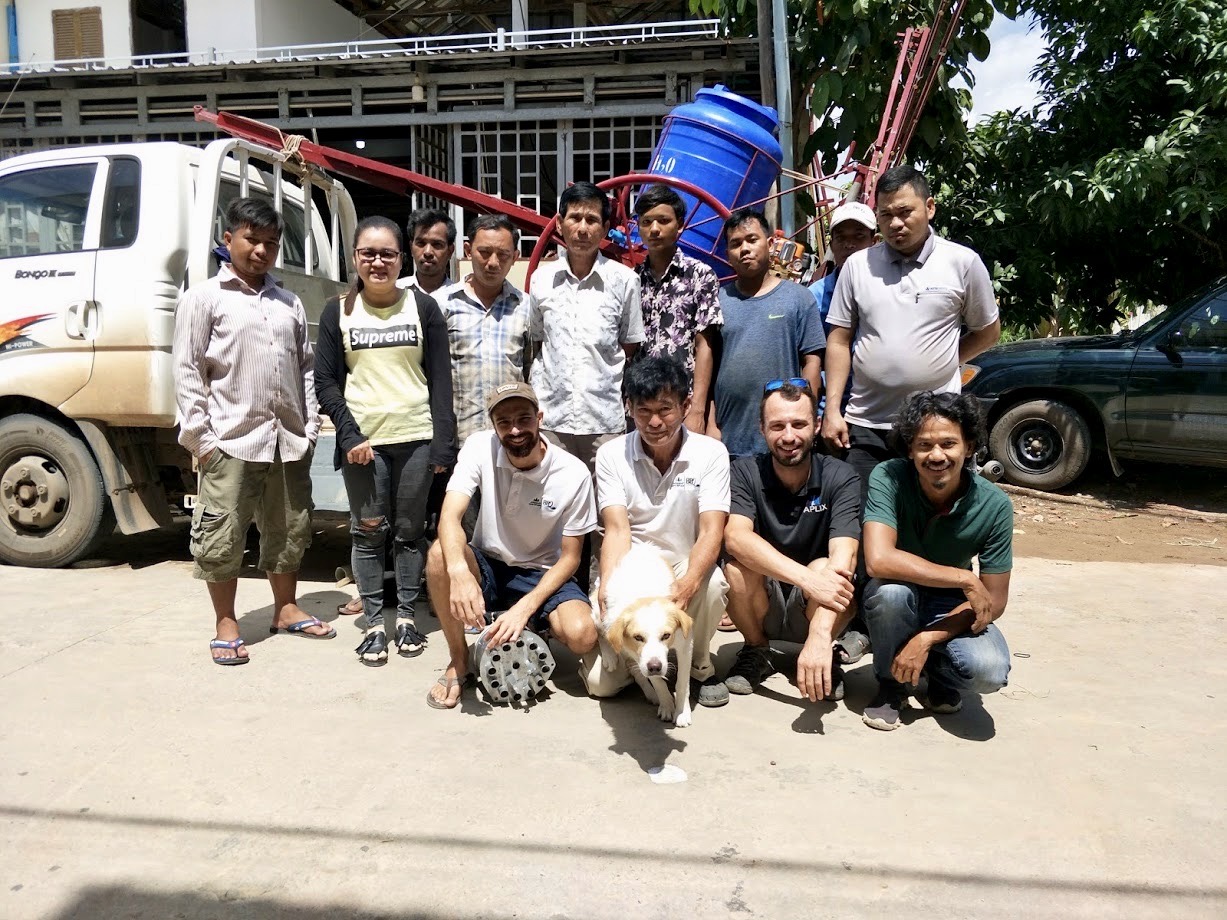It takes a village to raise a child and it took a “village” of experts to develop new machinery designed to raise the efficiency and productivity of Cambodian farmers.

The metered seeder rapidly dispenses a few evenly spaced seeds at a time without sacrificing airpower or tractor speed. (Photo: Agri-Smart/BB2C)
.
It takes a village to raise a child and, in Cambodia, it took a “village” of experts to develop new machinery designed to increase the efficiency and productivity of farmers.
Mechanization, a critical input for agricultural crop production, has been largely disregarded in developing countries, according to the United Nations Food and Agriculture Organization (FAO).
Increasing the availability and access to farm machinery means the farmers are able to accomplish more tasks at the right time.
In Boeng Pring Village in Battambang, the use of mini-combine harvester (a machine that could reap, collect, thresh, and clean) enabled farmers to harvest their crops in a matter of days instead of weeks. A large combine harvester with a cutting width of three meters, for example, can harvest a hectare in only an hour. Since the harvesting occurs towards the end of the dry season, it is now less likely for the ripe crops to remain unharvested in the field at the onset of the rainy season. Additionally, a farmer needs to hire at least 25 workers to manually harvest a hectare of rice field and pay each one around USD 4.00 per day or up to USD 120.00 per hectare. Hiring a combine harvester with an operator, on the other hand, costs about USD 100.00 (rates are for 2010).
Additionally, because many people prefer to work in other industries, the shortage of agriculture workers, particularly on rice farms and during the harvest, has led to higher production costs.
The benefits of sustainable agricultural mechanization are not limited to farmers. It can also significantly contribute to the upgrading of the value chains and food systems through improved postharvest, processing, and marketing, according to the FAO.
The metered seeder is one of the promising machinery from Agri-Smart Cambodia and its partner Brooklyn Bridge to Cambodia (BB2C). Agri-Smart Cambodia is a home-grown social enterprise operating under BB2C, a nonprofit organization that promotes entrepreneurship in the country.
.
Behind this project are people who contributed to its development and success including engineers Ibrahim FitzGibbon, Tony Morvant, and Veasna Srey and chief fabricator Pi Oum. They all worked under the guidance of Bunika San, the BB2C country director.
The following personal accounts paint the evolution of the machine starting from the initial idea to its working reality.
When we as engineers sit down to design a device, we think about how we can transform simple materials and techniques into sophisticated, functioning technology
Ibrahim FitzGibbon
Lead Engineer, BB2C/Agri-Smart Cambodia
In the rugged fields of Cambodia, unkempt and unpredictable, I have come to expect the unexpected. Erratic rainfalls, saturated, sinking sands, less-than-level ground…it seems the only constants are a shortage of labor, wealth, and know-how. With all these elements in mind, how does one begin developing a rice seeder here?

Filling the metered seeder with paddy for sowing. The metered seeder is attached to a 4-wheel tractor. (Photo: Agri-Smart/BB2C)
Agri-Smart’s first venture into direct rice seeding, the Eli Rice Seeder, utilizes air power as a vehicle to plant seeds. It has fared well in Cambodia for a number of reasons. The air-propelled seeds penetrate the muddy ground, lodging them securely from wind and pests. And the backpack air blower is inexpensive and multi-purpose; farmers can use it to spray other pre/post-seed treatments. Airflow transfers a plentiful stream.
But it is not the more the merrier when it comes to rice seed. Rice crops need room to grow, gaps through which light can flow, and space for other resources such as mechanical weeders and the like. What we need is a way of doling out the seeds periodically across, and along, rows.
Ground-level innovation
Our novel seed metering device does just that. A spinning rotor in a drum rapidly dispenses a few seeds at a time to each row at a rate relative to the speed of the moving seeder. The result is evenly spaced gaps between each seed deposit without sacrificing airpower or tractor speed.
Seeding in such a measured fashion does not just improve yield, it also saves seed. On average, the Eli Seeder requires roughly 40 to 120 kilograms of rice seed per hectare, depending on the duration of the time from planting to harvesting. Whereas broadcasting (the prevailing, labor-intensive method of tossing seed by hand) uses three times this amount. Using less rice seed, in turn, means you can use higher quality rice seed. Broadcasting so wastefully leaves farmers no choice but to use extremely degenerate seed that yields sub-par results.
The engineering mindset
When we as engineers sit down to design a device like the seed meter, we think about how we can transform simple materials and techniques in our environment into sophisticated, functioning technology. We use PVC pipe and wire spiral hose that are widely available. We let 3D-printed bespoke parts do the hard work, with cunning geometry that guides the seed and airflow, adaptable at no extra cost. And we laser cut only parts that require high tolerances. In such ways we avoid levying onerous bills on the farmers we want to help.
Because in a country where the majority of the rice crop is still hand sown by impoverished farmers, hefty, branded seeders costing thousands of dollars are not an option. Low-budget, mechanized solutions have fallen flat on the ground, too, for being too complicated, lacking versatility, and, ultimately, incapable of capturing the farmers’ imagination who are already stunted by a recent history of traumatizing social and economic conditions.

An early iterative design of the metered seeder attached to a 2-wheel tractor. (Photo: Agri-Smart/BB2C)
.
I am so relieved to see the seed metering system shooting the rice beautifully into even rows.
Bunika San
Country Director, BB2C
For an American Cambodia who came back home after being far away for 30 years, I felt like I was in the twilight zone. I was amazed that Cambodia is still farming just like the US did in the 1930s. I observed there were many people in the rice field, it took nearly 40 people to plant rice in one hectare and most of them are women. The men only do the heavy work then they sit and drink rice wine after.
I am very fortunate that I have a good education in the US and had the opportunity to learn and gain business experience. I went to the University of Riverside California and pursued a degree in horticulture because I always believed that I would return to Cambodia and help rebuild my country so we can be comparable to other ASEAN countries.
I bought a small rice field and tried to plant rice to see for myself. In early 2000, Cambodia saw a manufacturing boom and many jobs were created, most of them in construction and garment factories. There was no way to find laborers to plant rice.
This was the time I met Paula Shirk, the founder and then chief executive officer of BB2C. This is when things started to move forward. Todd Hyman, Ibrahim, and many of the interns and volunteers started to come and help make this dream possible.
Today, I am so relieved to see the metered seeder shooting paddy beautifully into even rows.

The “Village People” behind the metered seeder: (front row from left to right) Ibrahim FitzGibbon, Bunika San, Tony Morvant, and Veasna Srey, (back row) the Khmer fabricators and staff who made a major contribution to the innovation, and mascot Lovy, the dog. (Photo: Agri-Smart Cambodia)
I don’t want to inflate the significance of the metered seeder device but it is revolutionary.
Paula Shirk
Founder, BB2C
We tested a 3D-printed prototype of the Timed Release Seeder in front of our office in Phnom Penh. We have been working at this for over two years. It is an exciting time. Ibrahim did not sleep well the night before. But after the test, he called it “a massive step forward!”
I don’t want to inflate the significance of the metered seeder device but it is revolutionary. This method did not exist before. It provides an exceptional method for planting rice, corn, mung beans, and soybeans. This combination of air-powered, evenly distributed seed dispersal and low cost could be the code to finally crack mechanized seeding in Cambodia. It is, at least, what makes our technology unique.
The following morning, after the test, the workshop staff eagerly started on the next stage which is designing the unit in metal. The staff even bought material out of their own pocket. Of course, we promptly refunded their money!
I wish I was there to experience it. It is simply remarkable what the team is doing. Tony and Veasna, our new engineers, whose fresh eyes and experience constantly amaze us all. Bunika, whose depth of knowledge continues to steer the engineers. Without the Khmer fabricators, we would be lost. I have such respect for their skills and their dedication to our mission.








This is all good news. Could-shold be a design / produuct of interest in other parts of Asia. But in the pictures above I cannot see how ground speed is connected and aids in regulation of seed rate? The problem with earlier versions was just this that- seed rate not linked to ground speed.